
Literacy is a great way to build language with all children, including children who use augmentative and alternative communication methods. Augmentative and Alternative Communication (AAC) is an umbrella term used to describe forms of communication that are not verbal speech. It can be gesturing, pointing to a picture, writing, pressing buttons, and/or using a speech generating device. There is a strong connection between literacy and language skills. Working on communication, reading, and writing is mutually reinforcing. Even if your child is not using their AAC device consistently, you can begin teaching literacy skills now by using shared reading techniques and predictable chart writing.
Shared reading is an interactive process in which a child joins in or shares the reading of a book with adult guidance and support. Shared reading builds vocabulary and basic communication skills, develops concepts about print, and teaches the purpose and pleasure of reading. The focus of shared reading should be on interacting with your child and making meaning. Here are some tips for shared reading:
-
- Comment
- Read the page
- Make a brief comment
- Model it on the AAC system
- Wait and give your child at least 5 seconds of processing time
- Ask
- Ask a question
- Wait expectantly for a response
- Gesture toward the AAC system if needed to encourage use
- Respond
- Honor any response
- Repeat or expand upon their response
- Wait for more communication
- Comment
-
- Completion
- Let your child complete a phrase with their AAC system
- E.g. If reading “Brown Bear, Brown Bear, What Do You See?”, you can say “Brown Bear, Brown Bear, What Do You…” and then model “see” on your child’s AAC system. As you read the book, you can fade your cues and wait expectantly for your child to use “see” independently.
- Recall
- Recall events or other information from the story
- E.g. “Tell me other animals in the story.”
- Open-ended questions
- Ask open ended questions
- E.g. “Which animal is your favorite?”
- Wh-questions
- Ask wh- (who, what, where, when) questions
- E.g. “What color is the dog?”
- Distance
- Ask your child questions that are related to the book and their life
- E.g. “Do you have a cat?”
- Completion
Pick a book that is short, engaging, relatable, and at an appropriate language level for your child
Predictable chart writing is a writing modeling technique that builds successful writing skills, even if a child is unable to speak or hold a writing instrument. Here is how to use it:
- Write a chart on a meaningful theme with a core based “sentence stem”.
- E.g. Write “I like _____” multiple times and add some sample endings, such as “I like chocolate.” Help your child brainstorm other items that could complete the sentence, such as “dog,” “playdoh,” etc.
- Re-read the chart.
- After the sentences are complete, re-read the sentences you and your child created together multiple times. Make sure to highlight the difference between each word in the sentence by pointing, clapping, or counting.
- Cut the chart into sentence strips.
- Make the sentence.
- Cut each sentence into individual words and help your child recreate the sentence. As your child manipulates the different words in the sentence, read it to them while pointing as a way to teach that reading goes from left to right. At the end, be sure to model the correct form of the sentence.
- Make a book.
- Your child can help glue the sentences and pictures of their favorite things into a book you can re-read over and over.
If you have questions about AAC, shared reading, or predictable chart writing, please reach out to your therapist. Emerge plans to offer an AAC & Literacy Group this summer and we would love the opportunity to work with your child!
Other resources:

0 Comments